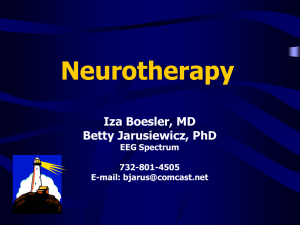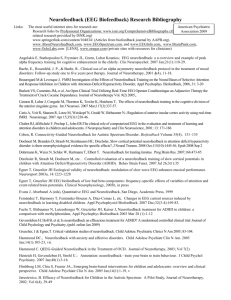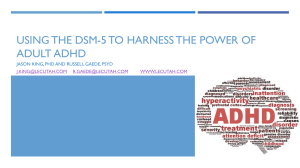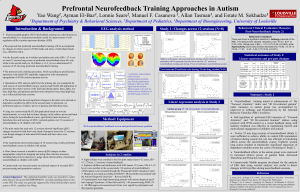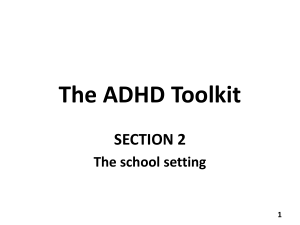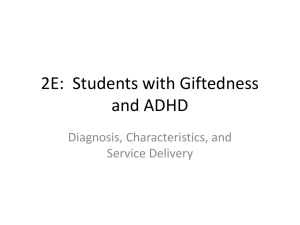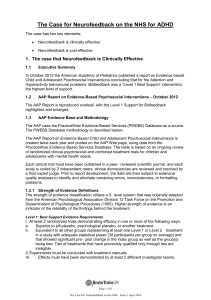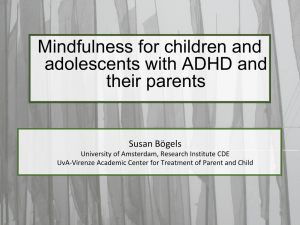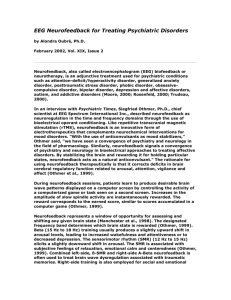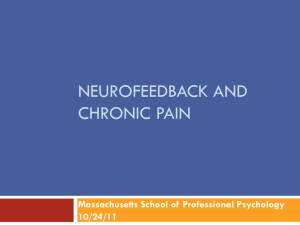Document
advertisement
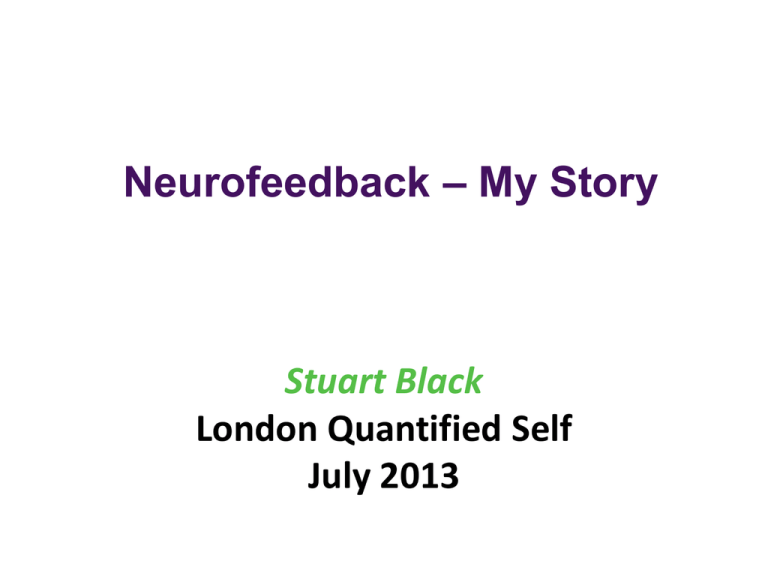
Neurofeedback – My Story Stuart Black London Quantified Self July 2013 Neurofeedback – My Story • • • • • • • • Introduction Neurofeedback & Quantified Self How I found Neurofeedback My Alpha Training Experience Discovery of Neurofeedback Application What is Neurofeedback ? What I’m Doing With Neurofeedback Now Questions 2 Introduction – Stuart Black • • • • • • • • BSc Electronics & Computer Systems Chartered Engineer Led weapon system development for fast jets inc. Eurofighter Change Management Consultant Executive Director at Bupa Cromwell Hospital for 3 years Interest in intersection of wellbeing & technology Interest in personal development Have a commercial interest in NF, but also a personal story to tell Quantified Self & Neurofeedback Monitoring (QS) Action Feedback • Neurofeedback integrates Monitoring (QS), Feedback & Action • Closes the loop in real time How I Found Neurofeedback (or How Neurofeedback Found me) Sir John Whitmore Ken Wilber Bill Harris Jim Hardt ‘20 years worth of meditation in a week’ Holosync Binaural Beats Technology My ‘Alpha Training’ Experience • • • • 12 hours a day in centre c. 5 hours Neurofeedback (no watches) Lengthy de-brief & coaching afterwards No nirvana, but much calmer & more focused • Went home, left job, got my ‘dream job’ as a consultant My ‘Alpha Training’ Experience Before After Earnings ‘Dream job’ Self-employed 1986 1987 1988 1989 1990 1991 1992 1993 1994 1995 1996 1997 1998 1999 2000 2001 2002 2003 2004 2005 2006 2007 2008 2009 2010 2011 2012 Alpha training My Discovery of Neurofeedback Application • • • • Majority of practitioners are using NF for therapeutic purposes History goes back to 1950s Therapeutic application discovered by accident – sleep research in cats Wide range of application from migraine to stroke recovery to epilepsy & ‘Chemo Brain’ • Body of evidence strong & growing 8 My Discovery of Neurofeedback Application • • • • Majority of practitioners are using NF for therapeutic purposes History goes back to 1950s Therapeutic application discovered by accident – sleep research in cats Wide range of application from migraine to stroke recovery to epilepsy & ‘Chemo Brain’ • Body of evidence strong & growing History of Neurofeedback Milestones in Neurofeedback and ADHD Treatment Neurofeedback is born. Joe Kamiya demonstrates control of Alpha waves in response to feedback. Barry Sterman initial research on cat brain training published. Psychology Today article on Alpha feedback. Barry Sterman suppreses epileptic seizures using Neurofeedback. First application of Neurofeedback to Hyperactivity Science article describing Anxiety training 1950s 1960s Ritalin marketed as adult anti-depressive. 1970s 1980s Othmers have been delivering NF training courses, equipment & clinical practice for 22 years Othmers’ EEG Spectrum run first Neurofeedback training course BrainTrainUK launched American Academy of Pediatrics raises EEG-biofeedback level 1 Evidence-Based Psychosocial intervention for Attention & Hyperactivity 1990s 2000s 2010s ADHD ‘invented’ with publication of DSM-III-R. US DEA highlights concerns at ‘quantity of stimulants that share virtually the same properties as cocaine’ Canadian authorities ban Cylert due to liver failures UK ADHD Medication grows 15,000 to 714,000 prescriptions per annum 10 Neurofeedback Training • NF is a tool to improve central nervous system regulation • NF ‘Holds a mirror up to the brain’ • Trains the brain’s ability to self-regulate by feeding back information on selected EEG rhythms related to regulation • Repeated sessions enable permanent learning – brain learns (or relearns) to work better without the computer • The brain itself does the real work Monitoring Action Feedback 11 What is Neurofeedback ? Feedback provided: ‘rewards’ when brain operates well, ‘inhibits’ when off-track Practitioner Frequency adjustment Client symptoms Sensor placement & feedback sight hearing Amplifier touch Feedback Video Games or Videos Client Neurofeedback trains the brain’s ability to self-regulate by feeding back information on selected EEG rhythms related to regulation 12 What is Neurofeedback ? 13 What I’m doing with NF now Therapeutic Neurofeedback: • ADHD • Autistic Spectrum • Epilepsy • Dyslexia, Dyspraxia, Dysgraphia • Sleep problems • Stroke recovery • Trauma recovery • ‘Chemo Brain’ • Fibromyalgia • Migraine • Depression, Anxiety • OCD • Vertigo, Tinnitus • PTSD, Addiction Peak Performance: • Limitations of performance • Emotional instability • Burn out • Lack of focus • Physical calming • Business performance • Leadership development • Personal development • Sports performance Egham, Surrey | London - Clapham Junction, Fitzrovia | Hoddesdon, Herts Thankyou for listening Questions ? stuart@braintrainuk.com BrainTrainUK.com 07796 266 377 @braintrainuk References Our website: braintrainuk.com The approach we take: eeginfo.com Leadership Development Framework: http://www.harthill.co.uk/leadership-development-framework/leadership-developmentframework.html Jim Hardt’s facility (now in Vancouver): biocybernaut.com Book on the history of NF: http://www.amazon.co.uk/Symphony-Brain-Evolution-Wave-Biofeedback/dp/0802143814 16 Backup Slides 17 Our NF Training Approach GP referral Self referral Specialist/school referral Free initial consultation Assessment Letter • Interview/report • Functional assessment (QIKtest) • Symptom selection Letter Training plan Brain Training session (45 mins) x 20 Symptom tracking QIK-TEST assessment Report Report Outcome evaluation 18 American Academy of Pediatrics – Oct 2012 Strength of Evidence Definitions Level 1: Best Support I. At least 2 randomized trials demonstrating efficacy in one or more of the following ways: a. Superior to pill placebo, psychological placebo, or another treatment. b. Equivalent to all other groups representing at least one Level 1 or Level 2 treatment in a study with adequate statistical power (30 participants per group on average) and that showed significant pre‐post change in the index group as well as the group(s) being tied. Ties of treatments that have previously qualified only through ties are ineligible. II. Experiments must be conducted with treatment manuals. III. Effects must have been demonstrated by at least 2 different investigator teams. 19 Sample Control Random Recent Evidence Base for NF for ADHD 2009 *Journal of Child Psychology and Psychiatry 102 ✓ ✓ 2006 *Neuroscience Letters 20 ✓ ✓ 2006 *Applied Psychophysiology and Biofeedback 20 ✓ ✓ 2009 Clinical EEG and Neuroscience 1,194 N/A N/A 2012 BMC Psychiatry 130 ✓ ✓ 2002 Applied Psychophysiology and Biofeedback 100 ✓ NF showed significant improvement in behavior, Ritalin did not. NF group showed normalisation of EEG, Ritalin group did not. 2005 Child and Adolescent Psychiaric Clinics of North America 100 ✓ NF group still showed improvement 2 years after end of NF, Ritalin effect ended on cessation of medication. 80% of NF group reduced Ritalin by > 50%; 85% of Ritalin group increased dose, 0 reduced. 2007 Applied Psychophysiology and Biofeedback 38 ✓ ✓ 2 different NF protocols showed improvement in all 4 measures. 2008 International Journal of Bioelectromagnetism 38 ✓ ✓ Improvements still present from NF 2 years after original trial. Year Journal Key Results/Conclusions Results indicate clinical efficacy of NF for children with ADHD. Results suggest NF has the capacity to functionally normalize brain systems mediating selective attention and response inhibition in ADHD children. Meta study concluded NF is efficacious & specific for ADHD. NF is as effective as methylphenidate. * Studies that directly led American Academy of Pediatrics to endorse NF as Level 1 evidence-based psychosocial intervention October 2012 20 Recent Evidence Base for NF The Journal of Child Psychology and Psychiatry - 2009 Gevensleben, H., Holl, B., Albrecht, B., Vogel, C., Schlamp, D., et al. (2009). Is neurofeedback an efficacious treatment for ADHD?: A randomized controlled clinical trial. Journal of Child Psychology and Psychiatry, 50, 780–789 Sample 102 children aged 8-12 with ADHD diagnosis. Control Attention control software training game. Outcome measurement Results Pre & post training assessments using parent & teacher behaviour rating scales. Improvements with NF group > control group. “Neurofeedback effects are substantial and of practical importance”. Conclusions “indicates clinical efficacy of neuorofeedback in children with ADHD”. 21 Recent Evidence Base for NF Neuroscience Letters - 2006 Levesque, J., Beauregard, M., & Mensour, B. (2006). Effect of neurofeedback training on the neural substrates of selective attention in children with attention deficit/hyperactivity disorder: A functional magnetic resonance imaging study. Neuroscience Letters, 394, 216–221. Sample 20 children with ADHD diagnosis. Control Control group had no NF training. Outcome measurement Pre & post training assessments of Counting Stroop test whilst brain activity was monitored using Functional MRI scan. Results Before training both groups showed abnormal brain function during test - no activity in anterior cingulate cortex (ACC). After training NF group showed significantly greater test score & significant activity in ACC. Conclusions Results “suggest that in ADHD children, neurofeedback therapy has the capacity to normalize the functioning of the ACC, the key neural substrate of selective attention”. 22 Recent Evidence Base for NF Applied Psychophysiology and Biofeedback - 2006 Beauregard, M., & Levesque, J. (2006). Functional magnetic resonance imaging investigation of the effects of neurofeedback training on neural bases of selective attention and response inhibition in children with attention-deficit/hyperactivity disorder. Applied Psychophysiology and Biofeedback, 31, 3–20 Sample 20 children with ADHD diagnosis. Control Control group had no NF training. Outcome measurement Pre & post training assessments of reaction and impulsivity test whilst brain activity was monitored using Functional MRI scan. Results Before training neither group showed activity in areas of brain associated with response inhibition. After training NF group showed significant test result improvements and fMRI showed significant activity in areas of the brain monitored. Conclusions Results “suggest that neurofeedback therapy has the capacity to functionally normalize the brain systems mediating selective attention and response inhibition in ADHD children”. 23 Recent Evidence Base for NF Clinical EEG and Neuroscience - 2009 Arns, M., de Ridder, S., Strehl, U., Breteler, M., & Coenen, A. (2009). Efficacy of neurofeedback treatment in ADHD: the effects on inattention, impulsivity and hyperactivity: a meta-analysis. Clinical EEG and neuroscience, 40(3), 180-189. Sample Meta study of 15 previous studies of application of NF to ADHD with aggregated participants of 1,194. Control N/A. Outcome measurement Results Conclusions The studies were analysed to assess to what extent it can be concluded that neurofeedback is an effective treatment for ADHD symptoms. The authors concluded “the clinical effects of neurofeedback in the treatment of ADHD can be regarded as clinically meaningful.” “We conclude that neurofeedback treatment for ADHD can be considered ‘Efficacious and Specific’ (level 5) with a high ES for inattention and impulsivity and a medium ES for hyperactivity.” 24 Recent Evidence Base for NF Clinical EEG and Neuroscience - 2009 Arns, M., de Ridder, S., Strehl, U., Breteler, M., & Coenen, A. (2009). Efficacy of neurofeedback treatment in ADHD: the effects on inattention, impulsivity and hyperactivity: a meta-analysis. Clinical EEG and neuroscience, 40(3), 180-189. Sample Meta study of 15 previous studies of application of NF to ADHD with aggregated participants of 1,194. Control N/A. Outcome measurement Results Conclusions The studies were analysed to assess to what extent it can be concluded that neurofeedback is an effective treatment for ADHD symptoms. The authors concluded “the clinical effects of neurofeedback in the treatment of ADHD can be regarded as clinically meaningful.” “We conclude that neurofeedback treatment for ADHD can be considered ‘Efficacious and Specific’ (level 5) with a high ES for inattention and impulsivity and a medium ES for hyperactivity.” 25 Recent Evidence Base for NF BMC Psychiatry – 2012 Duric NS, Assmus J, Gundersen DI, Elegen IB. (2012). Neurofeedback for the treatment of children and adolescents with ADHD: A randomized and controlled clinical trial using parental reports. BMC Psychiatry, 12:107 Sample 130 ADHD diagnosed children aged 6-18 Control 3 groups: 1.NF; 2. Methylphenidate; 3. Methylphenidate + NF. Outcome measurement Results Conclusions Parental reports. NF as effective as medication. “NF produced a significant improvement in the core symptoms of ADHD, which was equivalent to the effects produced by MPH, based on parental reports. This supports the use of NF as an alternative therapy for children and adolescents with ADHD.” 26 Recent Evidence Base for NF Applied Psychophysiology and Biofeedback – 2002 Monastra, V.J., Monastra, D.M. & George, S. (2002) The effects of stimulant therapy, EEG biofeedback, and parenting style on the primary symptoms of attentiondeficit/hyperactivity disorder. Applied Psychophysiology and Biofeedback, Vol 27, No 4, p231-249 Sample 100 children aged 6-19 with ADHD diagnosis Control Group 1.Ritalin + academic support + parental coaching; 2. As 1 + NF. Parent & teacher rating scales. Outcome EEG measurement in areas associated with attention. measurement Attention & impulsiveness test. Results Conclusions After 1 year, control group (no NF) improvement not robust. NF group showed significant improvement. Whilst Ritalin still being taken, only NF group showed improvement in EEG activity to ‘normal’ levels. “stimulant therapy would appear to constitute a type of prophylactic intervention, reducing or preventing the expression of symptoms without causing an enduring change in the underlying neuropathy of ADHD”. 27 Recent Evidence Base for NF Child and Adolescent Psychiatric Clinics of North America – 2005 Monastra VJ (2005). Electroencephalographic biofeedback (neurotherapy) as a treatment for attention deficit hyperactivity disorder: rationale and empirical foundation. Child Adolesc Psychiatric Clin N Am, 14, 55– 82 Sample 100 children aged 6-19 with ADHD diagnosis Control Group 1.Ritalin + academic support + parental coaching; 2. As 1 + NF. Parent & teacher rating scales. Outcome EEG measurement in areas associated with attention. measurement Attention & impulsiveness test. Results Conclusions Follow-on study to Monastra et al (2002). 2 years after NF ended, NF group continued to demonstrate improvements on a 3 measures – biological, behavioural, neuropsychological. 80% of NF group had decreased their Ritalin dose by more than 50%. 85% of the control group had increased their Ritalin dose, none had reduced it. 28 Recent Evidence Base for NF Child and Adolescent Psychiatric Clinics of North America – 2005 Monastra VJ (2005). Electroencephalographic biofeedback (neurotherapy) as a treatment for attention deficit hyperactivity disorder: rationale and empirical foundation. Child Adolesc Psychiatric Clin N Am, 14, 55– 82 Sample 100 children aged 6-19 with ADHD diagnosis Control Group 1.Ritalin + academic support + parental coaching; 2. As 1 + NF. Parent & teacher rating scales. Outcome EEG measurement in areas associated with attention. measurement Attention & impulsiveness test. Results Conclusions Follow-on study to Monastra et al (2002). 2 years after NF ended, NF group continued to demonstrate improvements on a 3 measures – biological, behavioural, neuropsychological. 80% of NF group had decreased their Ritalin dose by more than 50%. 85% of the control group had increased their Ritalin dose, none had reduced it. 29 Our NF Training Approach • Self referral or referral by GP/specialist/school • Initial (free) consultation • Assessment: Interview/report, neuropsychological testing (QIKtest), symptom tracking • Report to GP, copied to referrer (with client consent) • Training – initial 20 sessions, 45 mins per session (30 mins NF), min 2x weekly • Evaluation – QIKtest, symptom tracking, client reporting • 20 sessions cost £1500 • Money-back guarantee offered for ADHD symptom improvement training if no improvement 30
